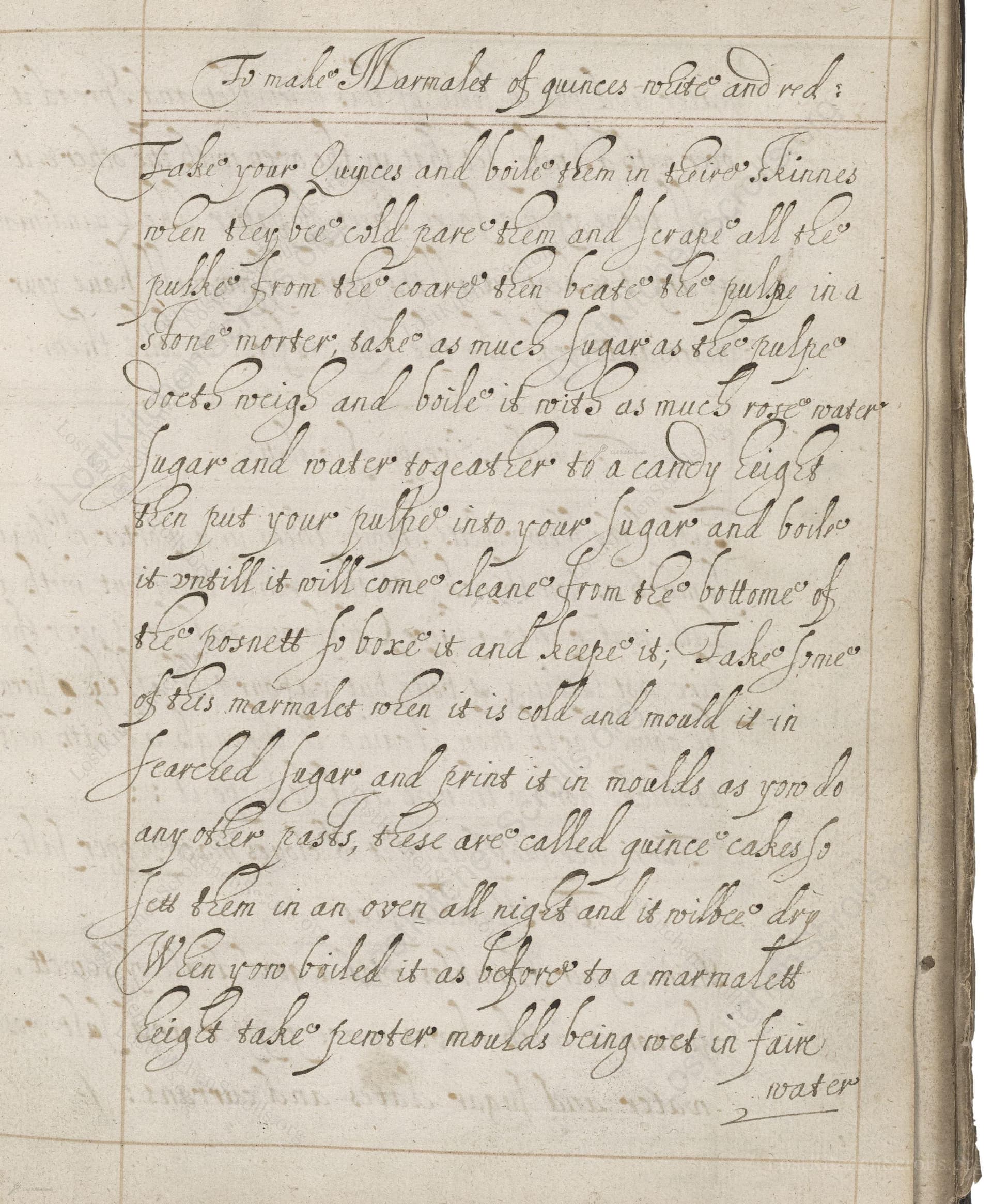To Make Marmalet Of Quinces White And Red
From the treasured pages of Medicinal and cookery recipes by John King
Written by John King

To Make Marmalet Of Quinces White And Red
"Take your Quinces and boile them in there skinnes when they bee cold pare them and scrape all the pulpe from the coare then beate the pulpe in a stone morter take as much sugar as the pulpe doeth weigh and boile it with as much rose water sugar and water togeather to a candy height then put your pulpe into your sugar and boile it untill it will come cleane from the bottome of the posnett so boxe it and keepe it. Take some of this marmalet when it is cold and mould it in searced sugar and print it in moulds as you do any other pasts, these are called quince cakes so set them in an oven all night and it will bee dry When you boile it as before to a marmalett height take pewter moulds being wet in faire water"
Note on the Original Text
The recipe follows the loose, conversational structure typical of early modern directions—intended for cooks who already had a working knowledge of kitchen processes. Spelling is phonetic ('doeth weigh', 'cleane from the bottome', 'boxe it'), reflecting the lack of standardized spelling until later in the 18th century. Quantities and timings are imprecise, relying instead on observable cues ('candy height', 'will come cleane from the bottome'). Such methods demand a familiarity with the tactile and visual stages of confectionery making.

Title
Medicinal and cookery recipes by John King (1675)
You can also click the book image above to peruse the original tome
Writer
John King
Era
1675
Publisher
Unknown
Background
A delightful journey into the kitchens of the 17th and early 18th centuries, this collection, attributed to John King, brims with time-honored recipes, culinary wisdom, and flavors that once graced historic tables.
Kindly made available by
Folger Shakespeare Library
This recipe for 'Marmalet of quinces' hails from the 17th or early 18th century, a period when sugar was both precious and celebrated, and preserving seasonal fruits was essential for winter. Such recipes were often found in the households of the English gentry, where highly sweetened preserves were prized luxuries, sometimes offered as gifts or served at banquets. The inclusion of rose water marks its status as a high-class confection, as exotic ingredients were fashionable and signified wealth and sophistication. It is as much a product of culinary ingenuity as it is of social aspiration.

The cook would have used a well-scrubbed posnet (a small, wide metal pot with a handle for boiling and reducing the preserve). A stone mortar and pestle was essential for breaking up the chilled quince pulp. Molds, often made from pewter, would imprint decorative patterns onto the finished quince 'cakes'. Sifting cloths or sieves helped dust sugar over the candies. Finally, ovens fueled by wood or coal would slow-dry the molded sweets overnight.
Prep Time
20 mins
Cook Time
1 hr 30 mins
Servings
20
We've done our best to adapt this historical recipe for modern kitchens, but some details may still need refinement. We warmly welcome feedback from fellow cooks and culinary historians — your insights support the entire community!
Ingredients
- 2.2 lb quinces
- 2.2 lb granulated sugar
- 3.5 fl oz rose water
- 3.5 fl oz water
- Icing sugar (for dusting; optional for molding)
- Substitute: pear or apple can be used in place of quinces for a milder flavor (not traditional)
Instructions
- Begin by taking quinces—about 2.2 pounds—and boiling them in their skins until fork-tender (45–60 minutes).
- Once cooled, peel them and scrape the pulp from the cores, discarding skins and seeds.
- Mash or blitz the pulp until smooth.
- Weigh the pulp and prepare an equal weight of granulated sugar (for 2.2 lb pulp, use 2.2 lb sugar).
- In a heavy pan, mix the sugar with 3.5 fl oz rose water and 3.5 fl oz water, heating gently to dissolve the sugar and bring it to a soft ball or 'candy' stage (239°F).
- Stir in the quince pulp and cook, stirring constantly, over medium heat until the mixture thickens and pulls away cleanly from the pan (about 20-30 minutes).
- Pour into shallow containers or silicone molds and allow to cool.
- For quince cakes, once set and chilled, dust the pieces in sifted icing sugar and press into decorative molds.
- Leave to dry in a low oven (around 160°F) overnight or until firm to the touch.
Estimated Calories
240 per serving
Cooking Estimates
It takes around 1 hour to cook the quinces until soft, then about 20–30 minutes to finish cooking with sugar. Preparing and peeling the quinces, weighing ingredients, and setting up your pans will take about 15–20 minutes. Each serving has about 240 calories if you divide the finished candy into 20 pieces.
As noted above, we have made our best effort to translate and adapt this historical recipe for modern kitchens, taking into account ingredients nowadays, cooking techniques, measurements, and so on. However, historical recipes often contain assumptions that require interpretation.
We'd love for anyone to help improve these adaptations. Community contributions are highly welcome. If you have suggestions, corrections, or cooking tips based on your experience with this recipe, please share them below.
Join the Discussion
Rate This Recipe
Dietary Preference
Main Ingredients

Den Bockfisch In Einer Fleisch Suppen Zu Kochen
This recipe hails from a German manuscript cookbook compiled in 1696, a time whe...

Die Grieß Nudlen Zumachen
This recipe comes from a rather mysterious manuscript cookbook, penned anonymous...

Ein Boudain
This recipe comes from an anonymous German-language manuscript cookbook from 169...

Ein Gesaltzen Citroni
This recipe, dating from 1696, comes from an extensive anonymous German cookbook...
Browse our complete collection of time-honored recipes



